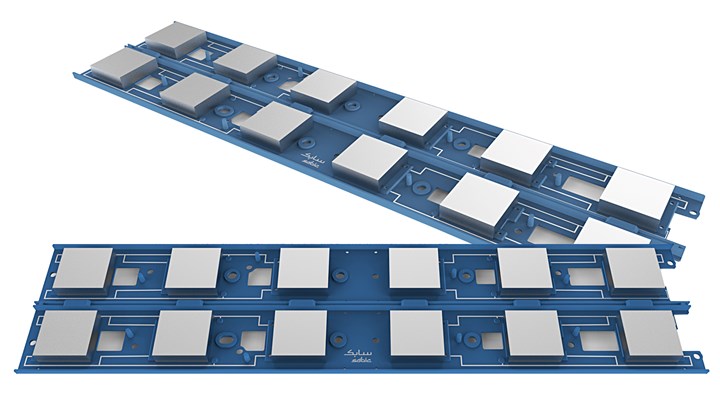Glass Reinforced PPS Compound for 5G Dipole Antennas
SABIC’s LNP Thermocomp OFC08V offers easy plating with LDS, warpage control and good RF performance.

A new glass fiber-reinforced PPS-based compound designed for 5G dipole antennas and other electrical/electronic applications has been launched by SABIC. LNP Thermocomp OFC08V reportedly features excellent plating performance using laser direct structuring (LDS), strong layer adhesion, good warpage control, high heat resistance, and stable dielectric and radio frequency (RF) performance. This unique combination of properties could enable an injection moldable new dipole antenna design, offering advantages over traditional printed circuit board (PCB) assembly and the selective electroplating of plastic.
This new compound can help the industry develop lightweight, cost-effective, all-plastic antenna designs that facilitate deployment of 5G infrastructure, according to Joshua Chiaw, business management director for SABIC’s LNP & Noryl specialties. “To help achieve 5G’s promise of faster speeds, increased data loads and ultra-low latency, RF antenna manufacturers are revolutionizing their designs, materials and processes. We are helping our customers simplify the production of RF antennas, which are used by the hundreds in arrays within active antenna units. Our latest high-performance LNP Thermocomp compound not only helps streamline manufacturing by avoiding post processing, but it can also deliver exceptional performance across multiple, critical areas. By continually developing new materials for 5G infrastructure, SABIC aims to accelerate expansion of this next-generation networking technology.”
LNP Thermocomp OFC08V is formulated for potential use in metal plating using LDS. The material reportedly offers a wide laser processing window and both ease of plating and uniformity in plating line width to help ensure stable and consistent antenna performance. Strong adhesion between the plastic and metal layers avoids delamination, even following thermal aging and lead-free reflow soldering. Improved dimensional stability and lower warpage compared to competitive glass-reinforced PPS grades are said to help achieve smooth fixation of the metal plating during LDS, as well as accurate assembly. Thanks to these attributes, this compound has been listed by LPKF Laser & Electronics, a German provider of laser manufacturing solutions, as an approved thermoplastic for LDS with the company’s systems.
Compared to the current, widely-used complex, multi-step selective electroplating process of plastic, LDS-enabled LNP Thermocomp OFC08V offers greater simplicity and higher productivity. After injection molding of the part, LDS only requires laser structuring and chemical plating. In addition, the new compound reportedly delivers all the performance benefits of glass-filled PPS, including high heat resistance for PCB assembly using surface mount technology, and inherent flame retardancy (UL-94 V0 at 0.8 mm). Low dielectric values (dielectric constant: 4.0; dissipation factor: 0.0045) and stable dielectric performance, together with good RF performance under harsh conditions, help optimize transmission and extend useful life.
Related Content
-
Prices of Volume Resins Generally Flat or Lower
Exceptions in early March were PP and PS, which moved up solely due to feedstock constraints, along with slight upward movement in PVC and PET.
-
General Polymers Thermoplastics to Further Expand Distribution Business
NPE2024: Following the company’s recent partnership buyout, new North American geographic territories are in its sight.
-
Tracing the History of Polymeric Materials, Part 26: High-Performance Thermoplastics
The majority of the polymers that today we rely on for outstanding performance — such as polysulfone, polyethersulfone, polyphenylsulfone and PPS — were introduced in the period between 1965 and 1985. Here’s how they entered your toolbox of engineering of materials.




